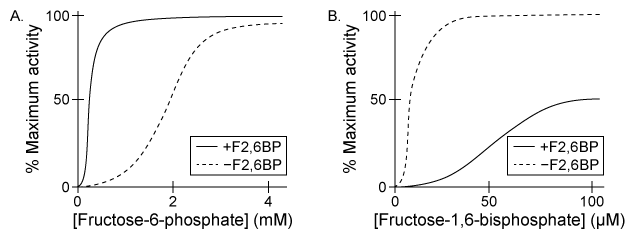Passage Glycolysis and Gluconeogenesis Are Tightly Regulated, Opposing Metabolic Pathways That
Passage
Glycolysis and gluconeogenesis are tightly regulated, opposing metabolic pathways that help control blood glucose levels. Glycolysis converts glucose to two pyruvate molecules, whereas gluconeogenesis consumes 6 ATP equivalents to convert two pyruvate molecules back to glucose. When glycolysis is upregulated, gluconeogenesis is downregulated, and vice versa.As shown in Figure 1, glycolysis and gluconeogenesis in the liver are largely regulated by the allosteric action of the small molecule fructose-2,6-bisphosphate (F2,6BP) on the enzymes phosphofructokinase-1 (PFK-1) and fructose-1,6-bisphosphatase (F1,6BPase) . PFK-1 is a kinase that uses ATP to phosphorylate fructose-6-phosphate (F6P) in an irreversible step of glycolysis, forming fructose-1,6-bisphosphate (F1,6BP) and ADP. During gluconeogenesis, F1,6BPase removes the phosphate group by hydrolysis.
 Figure 1 Activities of (A) PFK-1 and (B) F1,6BPase in the presence (solid lines) and absence (dashed lines) of F2,6BPA bifunctional enzyme that contains a phosphofructokinase-2 (PFK-2) domain and a fructose-2,6-bisphosphatase (F2,6BPase) domain controls F2,6BP levels in the liver. The PFK-2 domain converts F6P to F2,6BP, and the F2,6BPase domain converts F2,6BP back to F6P. When blood glucose levels are low, the enzyme becomes phosphorylated. This phosphorylation event simultaneously activates the F2,6BPase domain and inactivates the PFK-2 domain. Under high blood glucose conditions, the enzyme becomes dephosphorylated, activating the PFK-2 domain and inactivating the F2,6BPase domain.
Figure 1 Activities of (A) PFK-1 and (B) F1,6BPase in the presence (solid lines) and absence (dashed lines) of F2,6BPA bifunctional enzyme that contains a phosphofructokinase-2 (PFK-2) domain and a fructose-2,6-bisphosphatase (F2,6BPase) domain controls F2,6BP levels in the liver. The PFK-2 domain converts F6P to F2,6BP, and the F2,6BPase domain converts F2,6BP back to F6P. When blood glucose levels are low, the enzyme becomes phosphorylated. This phosphorylation event simultaneously activates the F2,6BPase domain and inactivates the PFK-2 domain. Under high blood glucose conditions, the enzyme becomes dephosphorylated, activating the PFK-2 domain and inactivating the F2,6BPase domain.
-If one glucose molecule is converted to pyruvate in the muscle and then the resulting pyruvate molecules are converted back to glucose in the liver, what is the net number of ATP equivalents consumed?
A) 2
B) 4
C) 6
D) 8
Correct Answer:
Verified
Q286: Researchers quantified the amount of protein produced
Q287: Passage
Glycolysis and gluconeogenesis are tightly regulated, opposing
Q288: Passage
Oxidative stress occurs in cells when reactive
Q289: Passage
Glycolysis and gluconeogenesis are tightly regulated, opposing
Q290: Passage
Oxidative stress occurs in cells when reactive
Q292: The Km of an enzyme is always
Q293: Passage
Oxidative stress occurs in cells when reactive
Q294: Passage
Glycolysis and gluconeogenesis are tightly regulated, opposing
Q295: Passage
Destabilase, an enzyme found in the saliva
Q296: Passage
Glycolysis and gluconeogenesis are tightly regulated, opposing
Unlock this Answer For Free Now!
View this answer and more for free by performing one of the following actions

Scan the QR code to install the App and get 2 free unlocks

Unlock quizzes for free by uploading documents